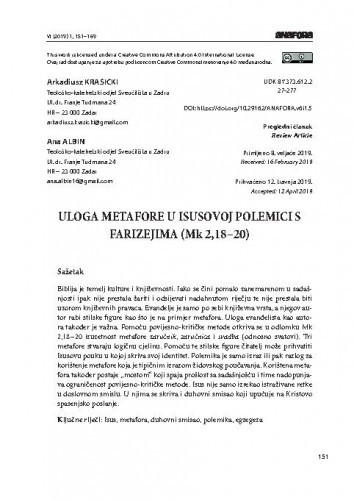Biblija je temelj kulture i književnosti. Iako se čini pomalo zanemarenom u sadašnjosti ipak nije prestala žariti i odsijevati nadahnutom riječju te nije prestala biti uzorom književnih pravaca. Evanđelje je samo po sebi književna vrsta, a njegov autor rabi stilske figure kao što je na primjer metafora. Uloga evanđelista kao autora također je važna. Pomoću povijesno-kritičke metode otkriva se u odlomku Mk 2,18−20 izuzetnost metafore zaručnik, zaručnica i svadba (odnosno svatovi). Tri metafore stvaraju logičnu cjelinu. Pomoću te stilske figure čitatelj može prihvatiti Isusovu pouku u kojoj skriva svoj identitet. Polemika je samo izraz ili pak razlog za korištenje metafore koja je tipičnim izrazom židovskog poučavanja. Korištena metafora također postaje „mostom“ koji spaja prošlost sa sadašnjošću i time nadopunjava ograničenost povijesno-kritičke metode. Isus nije samo izrekao istraživane retke u doslovnom smislu. U njima se skriva i duhovni smisao koji upućuje na Kristovo spasenjsko poslanje.; The Bible is the foundation of culture and literature. Even though it seems somewhat neglected today, it still emanates and shines with inspirational words and continues to be a model for literary movements. The Gospel is a literary genre in itself, and its author uses stylistic devices, such as the metaphor. The role of the evangelists as authors is also important. Using the historical-critical method, the passage Mk 2: 18-20 reveals the exceptional nature of the metaphor fiancé, fiancée, and wedding (i.e. wedding guests). The three metaphors make up a logical unit. With the help of that stylistic device, the reader can accept Jesus' teaching in which he conceals his identity. A polemic is just an expression or a reason for using a metaphor, which is a common expression in Jewish teachings. The metaphor that is used also becomes a “bridge” connecting the past with the present and thereby complements the limitations of the historical-critical method. Jesus not only spoke the investigated lines in the literal sense. They also contain a hidden spiritual meaning that indicates Christ’s mission of salvation.
Sažetak

 Anafora : časopis za znanost o književnosti = [academic literary journal] : 6,1(2019) / glavni i odgovorni urednik, editor-in-chief Ružica Pšihistal.
Anafora : časopis za znanost o književnosti = [academic literary journal] : 6,1(2019) / glavni i odgovorni urednik, editor-in-chief Ružica Pšihistal.